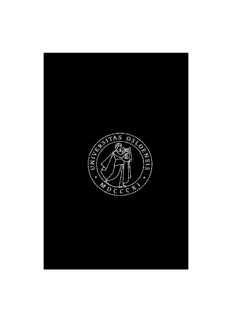
The Involvement of Domestic Actors in Foreign Policy Making PDF
Preview The Involvement of Domestic Actors in Foreign Policy Making
The Involvement of Domestic Actors in Foreign Policy Making The Netherlands and the Arctic Johan Verbeek Wolthuys Master’s in Peace and Conflict Studies Department of Political Science UNIVERSITY OF OSLO Spring 2016 II The Involvement of Domestic Actors in Foreign Policy Making The Netherlands and the Arctic A Case Study Author: Supervisor: Johan Verbeek Wolthuys Svein Vigeland Rottem 23 May 2016 Word count: 29610 III © Johan Verbeek Wolthuys 2016 The Involvement of Domestic Actors in Foreign Policy Making: The Netherlands and the Arctic Johan Verbeek Wolthuys http://www.duo.uio.no/ Print: Fridtjof Nansens Institutt IV Abstract The Netherlands has intermittently been active in the Arctic since the seventeenth century, but it was not until the early 2000s that a foreign policy covering its Arctic priorities was created. In April 2016, the Ministry of Foreign Affairs of the Netherlands published the Polar Strategy 2016-2020 to present and clarify its objectives in the Polar Regions as well as the instruments to reach them. The main research question considered in this thesis is: To what extent were domestic stakeholders involved in the framing of the priorities of the Netherlands vis-à-vis the Arctic? Using three conceptual models developed by Graham T. Allison (1971) to facilitate the measurement of the level of stakeholder involvement, three types of dynamics are considered in the development process. Firstly, the main policy maker (the Ministry of Foreign Affairs, MFA) is free to involve stakeholders at its own convenience, deciding to accept their input or not (Model I); secondly, the policy maker acts as a coordinator of an organized structure of contributors (Model II); and the MFA one player among several others, and it has to bargain with those actors in order to achieve its objectives (Model III). This thesis finds that characteristics all three types of dynamics between involved actors and the MFA can be identified simultaneously in the policy making process. This indicates that domestic stakeholders are to a varying degree involved in the policy making process. The extent of their involvement seems to depend on whether their non- involvement in the policy making effort would jeopardize the process. As various different types of actors are forming a more organized structure, it becomes more challenging to categorize the actors as belonging to one of Allison’s conceptual models. V VI Acknowledgements Many have helped me during the writing of this thesis. I would like to thank a few of them here. First and foremost, I would like to express my gratitude to the Fridtjof Nansen Insitute (FNI). Not only was I offered a place to write this thesis as a Graduate Student Researcher, but FNI also financially supported my fieldwork in the Netherlands. I especially enjoyed the comfortable, welcoming, and inspiring work environment at FNI. A special thank you goes to my supervisor Svein Vigeland Rottem (Head Researcher of the Arctic Program at FNI). His knowledge, creativity, and ability to motivate contributed to making this experience a very pleasant one. Ambassador Bea Ten Tusscher and Arne O’Donoghue from the Embassy of the Netherlands to Norway deserve to be mentioned here. The idea to write on this topic was born while working alongside them as an intern. Their support has been an asset to the completion of this project. My fellow students, both at the University of Oslo and FNI, have been a constant source of encouragement and support. I am very grateful for the time we were able to work and study together. I would also like to thank the Van Beek family, as well as Anna Köberich and Peter J. Coles, for hosting me when I was doing fieldwork in the Netherlands. Their help is highly appreciated. Finally, I would like to express my gratitude to my family and friends for their constant interest in my work, words of advice, and continued backing. All inaccuracies remain my own. Johan Verbeek Wolthuys Polhøgda, 23 May 2016 VII VIII Contents The Involvement of Domestic Actors in Foreign Policy Making ......................................... III Abstract .................................................................................................................................... V Acknowledgements ............................................................................................................... VII 1 Introduction ...................................................................................................................... 1 1.1 Specification of Topic ................................................................................................. 1 1.2 Hypotheses ................................................................................................................. 4 1.3 Methodology ............................................................................................................... 6 1.3.1 Methodological Framework ............................................................................... 6 1.3.2 Data ...................................................................................................................... 8 1.3.3 Qualitative Interview Design ............................................................................. 9 1.4 Structure ................................................................................................................... 11 2 Theory .............................................................................................................................. 13 2.1 Allison’s Conceptual Models ................................................................................... 14 2.1.1 Model I ............................................................................................................... 15 2.1.2 Model II .............................................................................................................. 17 2.1.3 Model III ............................................................................................................ 20 2.2 Critique ..................................................................................................................... 22 3 Background ..................................................................................................................... 24 3.1 Historical perspective .............................................................................................. 24 3.2 The Polar Strategy .................................................................................................... 28 3.2.1 Climate and environment ................................................................................ 29 3.2.2 Economic considerations ................................................................................. 32 3.2.3 Geopolitics and governance ............................................................................. 34 3.3 Summary ................................................................................................................... 37 4 Empirical Data and Analysis .......................................................................................... 39 4.1 Introduction.............................................................................................................. 39 4.2 The Stakeholders ..................................................................................................... 40 4.2.1 Ministry of Foreign Affairs ................................................................................ 43 4.2.2 Domestic actors: Climate and environment ....................................................... 44 4.2.3 Domestic actors: Economic considerations ........................................................ 53 4.2.4 Domestic actors: Geopolitics and governance ................................................... 62 IX 4.3 Dutch Arctic Circle ................................................................................................... 65 4.4 Summary ................................................................................................................... 68 5 Conclusions ...................................................................................................................... 74 Literature list .......................................................................................................................... 78 Appendix ................................................................................................................................. 87 Annex 1: Arctic boundaries .................................................................................................. 87 Annex 2: Informants ........................................................................................................... 88 Annex 3: Interview guides ................................................................................................. 90 X
Description: